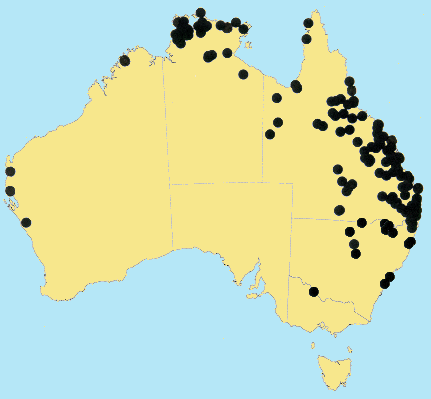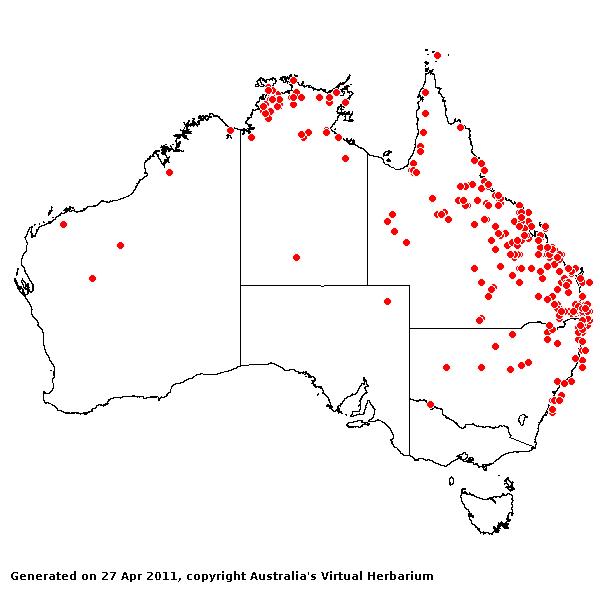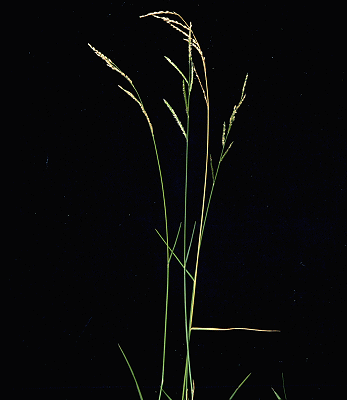Eriochloa procera (Retz.) C. E.
Hubbard. Bull.
Misc. Inform. 256
(1930).
Classification. (GPWG 2001) : Subfamily
Panicoideae. Paniceae.
Basionym and/or
Replacement Name: Agrostis
procera Retz, Obs.4: 19 (1786).
Type of Basionym or
Protologue Information: India, Malabar: Koenig (LD holo).
Key references
(books and floras): [1810]. R.Brown, Prodromus (188 as Paspalum
polystachyum), [1878] G.Bentham, Flora Australiensis 7 (463 as Eriochloa
annulata), [1969] E.E.Henty, Manual Grasses New Guinea (101),
[2002] D.Sharp & B.K.Simon, AusGrass, Grasses of Australia, [2006]
J.Jessop, G.R.M.Dashorst, F.M.James, Grasses of South Australia (453),
[2008] S.W.L.Jacobs, R.D.B.Walley & D.J.B.Wheeler, Grasses of New South
Wales (264).
Illustrations:
[2006] J.Jessop, G.R.M.Dashorst, F.M.James, Grasses of South Australia (453, fig. 385), [2008] S.W.L.Jacobs, R.D.B.Whalley
& D.J.B.Wheeler, Grasses of New South Wales, 4th edn (264).
Habit. Annual
or perennial. Culms erect or geniculately ascending, 20–120 cm tall. Ligule a
fringe of hairs, 0.7–1.2 mm long. Leaf-blades 2–40 cm long, 2–8 mm wide.
Leaf-blade surface smooth.
Inflorescence.
Inflorescence compound, a panicle of racemes. Racemes 3–10, 2–10 cm long.
Central inflorescence axis 4–20 cm long.
Spikelets.
Spikelets pedicelled. Fertile spikelets 2-flowered, the lower floret barren
(rarely male), the upper fertile, comprising 1 basal sterile florets,
comprising 1 fertile floret(s), without rachilla extension, lanceolate,
dorsally compressed, (2.5–)3–4 mm long.
Glumes. Glumes
thinner than fertile lemma. Upper glume elliptic, 2.8–3.7 mm long, membranous,
without keels, 5 -nerved. Upper glume surface indumented. Upper glume apex
muticous. Florets. Basal sterile florets 1, barren, without significant
palea. Lemma of lower sterile floret 90 % of length of spikelet, 5 -nerved,
muticous.
Fertile lemma 1.7–2.2
mm long, without keel. Lemma apex mucronate. Median (principal) awn 0.3–0.5 mm
long overall.
Continental
Distribution: Africa, Temperate Asia, Tropical Asia, Australasia, Pacific,
and South America.
Australian
Distribution: Western Australia, Northern Territory, South Australia,
Queensland, New South Wales.
Western Australia:
Gardner. Northern Territory: Darwin & Gulf. Queensland:
Burke, Burnett, Cook, Darling Downs, Leichhardt, Mitchell, Moreton, North
Kennedy, Port Curtis, South Kennedy, Warrego, Wide Bay, Gregory North. New
South Wales: North Coast, Central Coast, North-Western Slopes,
North-Western Plains, South-Western Plains.
Notes.
Asian and African specimens have an acute to acuminate spikelet apex, spikelet
length mostly below 3.9 mm and spikelets not arranged orderly on the primary
branches. Many Australian specimens previously identified as E. procera
possess neatly arranged secund spikelets with an aristate apex. It seems that E.
procera has been misinterpreted in Australia and these aristate specimens
belong to another species, probably E. decumbens. Eriochloa procera
is native to Australia, but is not as widely distributed as previously
believed.
In tropical and
subtropical rain forests, tropical and subtropical wet sclerophyll forests,
Brigalow forests, tropical and subtropical sub-humid woodlands, temperate
sub-humid woodlands, semi-arid shrub woodlands, and coastal grasslands. Flowers
sporadically throughout the year.







